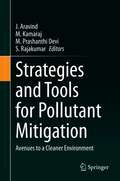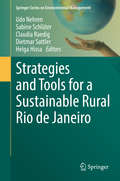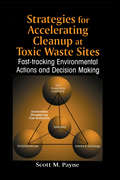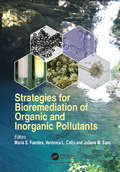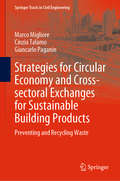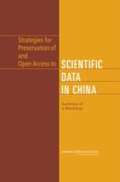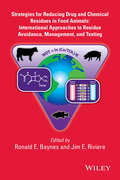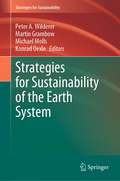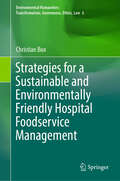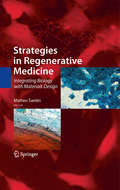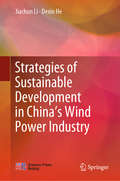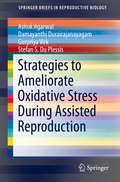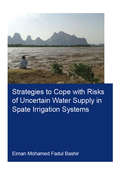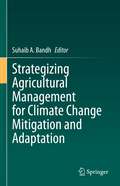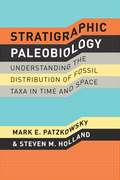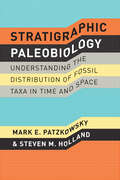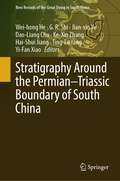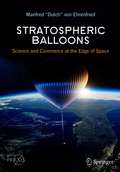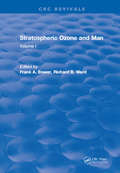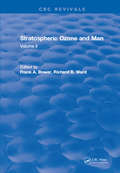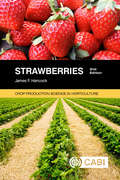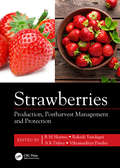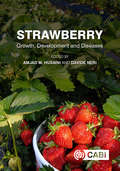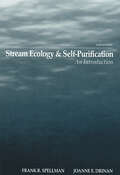- Table View
- List View
Strategies and Tools for Pollutant Mitigation: Avenues to a Cleaner Environment
by J. Aravind M. Kamaraj M. Prashanthi Devi S. RajakumarThis volume explores recent research trends and achievements in environmental pollution remediation (e.g. water, air, soil), and compiles critical and constructive papers and reviews with a focus on advances in bioremediation and green technology solutions for waste minimization, waste management and pollution control. The book is timely, as the need for researchers and engineers to develop sustainable and green eco-friendly remediation technologies is increasing with a growing global population, stressed agricultural systems, and an environment impacted by climate change. A key focus of the book is on the efficient use of agricultural waste residues as viable substrates for creating materials for environmental clean-up, and the possible conversion of these pollutants to sustainable bioresources. The volume will be of interest to sustainability researchers, environmental engineers, industry managers and agricultural scientists.
Strategies and Tools for Pollutant Mitigation: Research Trends in Developing Nations
by J. Aravind M. Kamaraj S. KarthikeyanThis book offers an overview of the latest work in environmental remediation and waste management coming out of developing nations. It is split into two sections: one on state-of-the-art sustainable remediation approaches, and the other covering waste management for a cleaner environment The ten chapters in this book are structured as reviews that assimilate recent works in these areas; they provide a centralized resource for scholars in developing nations who are working in environmental remediation and waste management. The volume will be of interest to sustainability researchers, environmental engineers, industry managers and agricultural scientists.
Strategies and Tools for a Sustainable Rural Rio de Janeiro (Springer Series On Environmental Management Ser.)
by Udo Nehren Sabine Schlϋter Claudia Raedig Dietmar Sattler Helga HissaThis book is a compilation of recent developments in land, ecosystem, and water management in the Brazilian state of Rio de Janeiro. The state is located in the biodiversity hotspot of the Atlantic Forest (Mata Atlântica), a biome characterized by high biological diversity and endemism. At the same time the state of Rio de Janeiro emerged to one of the economic hubs in Latin America. This development process has been accompanied by population growth, industrialization, urbanization, as well as consumption and degradation of land and water resources. In the past years many efforts have been made to stop or at least slow down these degradation processes and restore degraded environments with the overall goal to bring together sustainable management of natural resources, nature conservation, and economic development. An overview is provided of the different strategies and tools that have been developed in the fields of agriculture, ecosystem management and biodiversity, integrated water management, land restoration, disaster risk reduction and climate change adaptation, as well as environmental governance and economic instruments. This book covers a wide spectrum from applied research to science‐policy interfaces, planning concepts, and technical tools and has a model character for other rural areas in Latin America. Target groups are scientists, practitioners, policy makers and graduate students in the field of environmental management. The different chapters are written by researchers and practitioners of the German‐Brazilian project INTECRAL (Integrated Eco Technologies and Services for a Sustainable Rural Rio de Janeiro), the rural development program Rio Rural under the state secretary for agriculture and animal husbandry, as well as invited scientists from Brazilian universities and research institutes. It bridges existing gaps between science, policies, and practice in rural development.
Strategies for Accelerating Cleanup at Toxic Waste Sites: Fast-Tracking Environmental Actions and Decision Making
by Scott Marshall PayneAccelerating Cleanup at Toxic Waste Sites: Fast-tracking Environmental Actions and Decision Making presents truly innovative advances in investigative and cleanup technologies, offering valuable solutions that streamline the data collection process, speed up the time it takes to characterize a site, and expedite decision making.Using easy to understand graphic displays, tables, text summaries, and real world case studies, and by synthesizing technical and regulatory reference information crucial to the development of effective cleanup strategies, this book provides the framework for environmental professionals to develop project and program approaches that meet today's needs.An advanced text for those with at least basic understanding of environmental investigation, cleanup, regulations, decision making, and policy development, Accelerating Cleanup at Toxic Waste Sites addresses the "human" side of the environmental industry and why it is perhaps one of the most important considerations for successful accelerated cleanup. This book takes the next step by providing managers, project teams, and other professionals with approaches that bring techniques, regulations, strategies, and people together into one comprehensive package that works.
Strategies for Bioremediation of Organic and Inorganic Pollutants
by Maria S. Fuentes Verónica L. Colin Juliana M. SaezIncreased awareness surrounding environmental protection has prompted the development of more ecofriendly technologies. This book provides useful information on technologies based upon the use of biological agents for environmental clean-up, including bacteria, yeast, fungi, algae, and plants. Some chapters refer to the direct application of products derived from plants and microorganisms for designing strategies of environmental remediation. The combination of strategies helps in efficient removal of pollutants generated from anthropogenic activities with minimal environmental impact. This book is meant for professionals involved in environmental technology and waste management.
Strategies for Circular Economy and Cross-sectoral Exchanges for Sustainable Building Products: Preventing and Recycling Waste (Springer Tracts in Civil Engineering)
by Cinzia Talamo Marco Migliore Giancarlo PaganinThis book offers a valuable tool for understanding current efforts to promote the reuse and enhancement of pre-consumer waste in the development of new products for the construction sector, as well as the financial and regulatory tools being used to support this trend. It explores the vast and complex topic of the circular economy from the perspective of strategies for the reuse/recycling of waste, and develops a number of key premises: waste reuse/recycling must be considered using a logic of cross-sectoriality, recognizing the need to enhance the “dialogue” between different sectors; pre-consumer waste is particularly interesting for the recycling market because the construction sector can reduce its environmental impacts by enhancing its capacity to use secondary raw materials and by-products from other sectors; and lastly, the manufacturing sector is currently experimenting with promising forms of reducing/recycling pre-consumer waste and is at the same time providing by-products that can be used in other production chains. As such, the book offers a valuable asset for professionals who are interested in sustainability in construction, and in the study of construction products; however, it will be equally useful for local decision-makers tasked with implementing development policies and innovations in the industrial sector.
Strategies for Preservation of and Open Access to SCIENTIFIC DATA IN CHINA: Summary of a Workshop
by National Research Council of the National AcademiesPreservation of and open access to digital scientific resources are essential to global research, yet the challenges in storing and maintaining access to these collections are substantial. China faces major hurdles in this regard. A workshop held in June 2004 in Beijing convened scientific information managers, digital archiving experts, national science policy and funding officials, and representatives of development organizations to explore the scientific and technical, legal and policy, institutional and economic, and management aspects of creating sustainable and accessible archives of digital health and environmental data in China.
Strategies for Reducing Drug and Chemical Residues in Food Animals
by Jim E. Riviere Ronald E. BaynesHighlighting international approaches; the book details strategies to minimize contamination, residue monitoring programs, and classes of drugs and chemicals that pose contaminant risk in livestock. Focuses attention on drug and chemical residues in edible animal products Covers novel computational, statistical, and mathematical strategies for dealing with chemical exposures in food animals Details major drug classes used in food animal production and their residue risks Highlights efforts at harmonizing and the differences among areas like US, EU, Canada, Australia, South America, China, and Asia, where the issue of chemical exposures has significant impact on livestock products Ties veterinary clinical practice and the use of these drugs in food animals with regulatory standards and mitigation practices
Strategies for Sustainability of the Earth System (Strategies for Sustainability)
by Peter A. Wilderer Martin Grambow Michael Molls Konrad OexleThis volume builds on an international workshop held in 2019, inspired by James Lovelock's "The Revenge of Gaia - Why the Earth Is Fighting Back, and How We Can Still Save Humanity". It, therefore, understands the Gaia concept as an umbrella term for the living world that planet Earth is hosting for nearly 4 billion years. Humankind has intervened in this ecosystem since its emergence on the planet about 2.5 million years ago, often with painful consequences for itself. In its reactions, the Earth system follows only the laws of nature. Consequently, humanity needs to develop strategies for a sustainable Earth system. This volume presents a unique trans- and interdisciplinary variety of approaches to this challenge, offering philosophical considerations as well as practical medical research. It addresses a broad knowledgeable and general audience in environmental management, public administration, and higher education alike.
Strategies for a Sustainable and Environmentally Friendly Hospital Foodservice Management (Environmental Humanities: Transformation, Governance, Ethics, Law #6)
by Christian BuxSustainable catering aspires to reduce the environmental impacts of foodservice by serving nutritional, safe and environmentally friendly meals, and Italy has embraced the adoption of environmentally friendly diets and the minimization of food waste by introducing the minimum environmental criteria. However, there may be some tension between these two actions as environmentally friendly diets may lead to greater waste. The present book, in the field of the research projects entitled “Monitoring agri-food resilience and environmental savings in Puglia” and “Green supply chain management in the hospital catering service”, has the overarching purpose to improve the understanding of environmental, economic and social sustainability of foodservice, by considering the significant variables of energy efficiency, environmental impacts, waste management, customer satisfaction and user nutrition. The book reports the findings of different studies conducted in the hospital foodservice.
Strategies in Regenerative Medicine
by Matteo SantinThis authoritative book offers a detailed overview of present and future tissue engineering approaches and their contribution to regenerative medicine. It combines comprehensive reviews of the biology and materials science underlying the development and regeneration of different types of tissues with descriptions of current and future strategies in regenerative medicine to meet clinical needs. Each chapter includes typical examples of methodologies and technical solutions as the basis for the most recent scientific findings and biomedical products, tables as mini-databases summarizing the most recent findings, and links to specific websites in the main body of the text to complement a traditional reference list. Strategies in Regenerative Medicine: Integrating Biology with Materials Design covers topics from basic biology and materials science to the link between biological processes in tissue regeneration and biomedical device/tissue engineering product performance. Key Features: (1) Provides a comprehensive overview of regenerative medicine in the framework of clinical and industrial needs; (2) Describes the use of biomaterials and tissue engineering constructs in clinical applications; (3) Presents the work of international experts according to consistent, well-defined editorial guidelines; (4) Reviews the underlying biology of tissue regeneration; (5) Includes student exercises, references to relevant websites, and perspectives on future research needs, making the book ideal for use as a teaching text.
Strategies of Sustainable Development in China’s Wind Power Industry
by Jiachun Li Dexin HeThis book reviews the status quo and visions for the future in the wind energy industry in China and around the globe, focusing on its roles in optimizing energy structure, alleviating environmental pollution, and coping with climate change. Providing a blueprint of wind power development till 2050, it suggests a series of further measures in the context of policies, regulations, laws, and marketing in order to overcome the existing bottlenecks. Moreover, it proposes a number of potential innovative technologies related to IT+ and advanced manufacturing, including integrated & distributed power and micro-grid systems, multi-energy complement, green and intelligent manufacturing, reliability design, blade design, manufacturing and maintenance, drive drain systems, and offshore wind farms. This book offers researchers and engineers insights into sustainable development in the wind power industry.
Strategies to Ameliorate Oxidative Stress During Assisted Reproduction
by Ashok Agarwal Damayanthi Durairajanayagam Gurpriya Virk Stefan S. Du PlessisThis book discusses the various antioxidants that are in use to overcome oxidative stress in an assisted reproduction setting. Antioxidant therapies may range from enzymatic and non-enzymatic antioxidants, either alone or in combination. While no one antioxidant regime has been identified as effective in improving fertilization and pregnancy rates, antioxidant supplementation has been shown to defend sperm cells from lipid peroxidation and oxidative damage to DNA, and thus improve pregnancy rates. The prevention of oxidative stress and its consequent damage is imperative to ensure a successful outcome of the in vitro fertilization procedure and embryo transfer. Strategies that could be employed to minimize or prevent the detrimental effects of OS during assisted reproduction include supplementation with various types of antioxidants.
Strategies to Cope with Risks of Uncertain Water Supply in Spate Irrigation Systems: Case Study: Gash Agricultural Scheme in Sudan (IHE Delft PhD Thesis Series)
by Eiman Mohamed Fadul BashirFlood based irrigation in particular spate irrigation relies on variable flood scenarios occurring every year. Management of spate flood for spate irrigation must cope with the variability and uncertainty of water supply. Coping with water supply risks is often the only way to harness the opportunities for a productive use of water in arid environment. Integrating and strengthening community responses into irrigation policies and improvement plans could ensure sustainable and productive spate irrigated systems that can achieve food security for the poor population. This research analyses and evaluates risks and coping strategies developed by farming communities in the Gash spate irrigation system in Sudan, Eastern Africa. The research has synthesized different coping strategies developed by farmers, water user associations and water managers to cope with low, high and untimely flood risks. The research provide different frameworks that can assist with the identification of risk sources, pathways and propagation as well as evaluation of locally developed strategies at field, secondary and intake systems. The findings of this study contribute to scarce knowledge on spate irrigation system and provide scientifically sound and evidence-based insights to aid informed policy and decision making to improve productivity and sustainability of the spate irrigation systems.
Strategizing Agricultural Management for Climate Change Mitigation and Adaptation
by Suhaib A. BandhThis volume aims to raise awareness and stimulate research on how agricultural management could help to mitigate climate change impacts, and focuses on technical progressions and innovations in climate change mitigation and adaptation. It addresses new innovations in agricultural technology and management with the goal of balancing agricultural production and its associated climate effects in a sustainable manner. The major topics covered include crop and soil management, techniques and technologies for emission reduction, irrigation, land degradation, pest and disease management, farmers' perspectives, and climate-smart agriculture policy. The book is geared towards students, researchers, and professionals in the fields of environmental science, agriculture science, and climate change.
Stratigraphic Paleobiology: Understanding the Distribution of Fossil Taxa in Time and Space
by Mark E. Patzkowsky Steven M. HollandWhether the fossil record should be read at face value or whether it presents a distorted view of the history of life is an argument seemingly as old as many fossils themselves. In the late 1700s, Georges Cuvier argued for a literal interpretation, but in the early 1800s, Charles Lyell's gradualist view of the earth's history required a more nuanced interpretation of that same record. To this day, the tension between literal and interpretive readings lies at the heart of paleontological research, influencing the way scientists view extinction patterns and their causes, ecosystem persistence and turnover, and the pattern of morphologic change and mode of speciation. With Stratigraphic Paleobiology, Mark E. Patzkowsky and Steven M. Holland present a critical framework for assessing the fossil record, one based on a modern understanding of the principles of sediment accumulation. Patzkowsky and Holland argue that the distribution of fossil taxa in time and space is controlled not only by processes of ecology, evolution, and environmental change, but also by the stratigraphic processes that govern where and when sediment that might contain fossils is deposited and preserved. The authors explore the exciting possibilities of stratigraphic paleobiology, and along the way demonstrate its great potential to answer some of the most critical questions about the history of life: How and why do environmental niches change over time? What is the tempo and mode of evolutionary change and what processes drive this change? How has the diversity of life changed through time, and what processes control this change? And, finally, what is the tempo and mode of change in ecosystems over time?
Stratigraphic Paleobiology: Understanding the Distribution of Fossil Taxa in Time and Space
by Steven M. Holland Mark E. PatzkowskyWhether the fossil record should be read at face value or whether it presents a distorted view of the history of life is an argument seemingly as old as many fossils themselves. In the late 1700s, Georges Cuvier argued for a literal interpretation, but in the early 1800s, Charles Lyell’s gradualist view of the earth’s history required a more nuanced interpretation of that same record. To this day, the tension between literal and interpretive readings lies at the heart of paleontological research, influencing the way scientists view extinction patterns and their causes, ecosystem persistence and turnover, and the pattern of morphologic change and mode of speciation. With Stratigraphic Paleobiology, Mark E. Patzkowsky and Steven M. Holland present a critical framework for assessing the fossil record, one based on a modern understanding of the principles of sediment accumulation. Patzkowsky and Holland argue that the distribution of fossil taxa in time and space is controlled not only by processes of ecology, evolution, and environmental change, but also by the stratigraphic processes that govern where and when sediment that might contain fossils is deposited and preserved. The authors explore the exciting possibilities of stratigraphic paleobiology, and along the way demonstrate its great potential to answer some of the most critical questions about the history of life: How and why do environmental niches change over time? What is the tempo and mode of evolutionary change and what processes drive this change? How has the diversity of life changed through time, and what processes control this change? And, finally, what is the tempo and mode of change in ecosystems over time?
Stratigraphy Around the Permian–Triassic Boundary of South China (New Records of the Great Dying in South China)
by Wei-Hong He G. R. Shi Ke-Xin Zhang Ting-Lu Yang Jian-Xin Yu Dao-Liang Chu Hai-Shui Jiang Yi-Fan XiaoThis book timely provides high-quality records of 32 PTB sections across different depositional settings from terrestrial to marine facies in South China, including descriptions of lithologies, high-resolution correlation of key boundaries and fossil occurrences at each section. This book also analyzes the patterns and processes of the community and ecosystem evolution over space and through time in the lead to the end-Permian mass extinction, and critically analyzes the mostly debated hypothesis, anoxia and volcanism, which were considered as the causes of mass extinction, based on the data from the studied sections of South China, together with materials from other regions of the world.
Stratospheric Balloons: Science and Commerce at the Edge of Space (Springer Praxis Books)
by Manfred “Dutch” von EhrenfriedStratospheric balloons are powerful tools used to study the Earth and its atmosphere, as well as the greater cosmos beyond. This book describes the science and technology behind modern stratospheric ballooning, along with the surprising ways it has impacted our daily lives.The book takes you through every step of the process, starting with an in-depth introduction to basic balloon types and their uses before delving into balloon construction and mission planning. Along the way, you will learn about the novel technologies that have radically changed these balloons and their ability to launch, control and navigate them over specific ground targets. Next follows an exploration of their incredible applications, including research in atmospheric science, cosmology and astronomy, earth studies, meteorology, and aerobiology, and also commercial capabilities such as Internet networks and high-altitude tourism.The community of scientists, engineers, and entrepreneurs involved in stratospheric ballooning is only ever growing. This book shows you how these national and international efforts have truly soared in recent years, and it will be an enjoyable read for anybody interested in learning more about how science and commerce are conducted in the stratosphere, at the edge of space.
Stratospheric Ozone and Man: Volume I
by Frank A. BowerThe book, as originally conceived, was to be limited to technical considerations, but the scientific course of event has been so interwoven with non-scientific, but nevertheless related events, the authors felt necessary to include an account of this situation. Accordingly, the book is divided into five sections entitled: � Stratospheric ozone � Atmospheric processes influencing stratospheric ozone � Does man influence stratospheric ozone � Effects and research � Public policy
Stratospheric Ozone and Man: Volume II
by Frank A. BowerThe book, as originally conceived, was to be limited to technical considerations, but the scientific course of event has been so interwoven with non-scientific, but nevertheless related events, the authors felt necessary to include an account of this situation. Accordingly, the book is divided into five sections entitled: � Stratospheric ozone � Atmospheric processes influencing stratospheric ozone � Does man influence stratospheric ozone � Effects and research � Public policy
Strawberries (Crop Production Science in Horticulture)
by James HancockThis new and updated edition of a popular text provides a broad, balanced review of the scientific knowledge of strawberries and their cultivation. The worldwide strawberry industry has grown substantially since the original book was published, and methods of culture have undergone extensive modifications. This volume incorporates important changes to the taxonomy of strawberries and new understanding of how its ancestors evolved. It includes coverage of new disease and pest control methods and recent developments in genomic information. These advancements have greatly improved our understanding of how flowering and fruiting is regulated, and will revolutionize the breeding of strawberries. Drawing on extensive research and practical experience, the author presents an essential text that: Includes new content on genomic data, trait genetics, and marker-assisted strategies for varietal improvement. Provides a thorough review of the evolution of the strawberry and the history of strawberry cultivation. Contains an up-to-date comparison of the cultural systems employed across the world and the physiology behind these practices. Presented in full-colour throughout, this is a core guide for academic and professional researchers, breeders and growers, advisors, extension personnel and students of horticulture.
Strawberries: Production, Postharvest Management and Protection
by Radha Mohan Sharma Rakesh Yamdagni Anil Kumar Dubey Vikramaditya PandeyThis book provides unparalleled integration of fundamentals and most advanced management to make this strawberry crop highly remunerative besides enhancing per capita availability of fruit even in the non-traditional regions of the world.
Strawberry: Growth, Development and Diseases
by Ana Aguado Gianluca Baruzzi Jesús M Cantoral Nieves Capote María Carbú Nadia R Chalfoun Manuel Chamorro Berta De Santos Juan C. Ricci Atilla Eris Walther Faedi Marina Gambardella Carlos Garrido Victoria E González-Rodríguez Carlos. F Grellet-Bournonville Hatice Gulen Verónica Hael-Conrad Gustavo G Martos Francesca Massetani Yoh-Ichi Matsubara Juan J Medina-Mínguez Rudy Montenegro Marisa Perato Cristina Quispe Fernando Romero S Sánchez Guillermo Schmeda-Hirschmann Mario Simirgiotis Ursula Tonello Ece Turhan Ezequiel Viveros-Valdez Y Wen Xu Farooq A Zaki Gustavo Martínez ZamoraMethods of strawberry cultivation have undergone extensive modification and this book provides an up-to-date, broad and balanced scientific review of current research and emerging challenges. Subjects covered range from plant propagation, architecture, genetic resources, breeding, abiotic stresses and climate change, to evolving diseases and their control. These topics are examined in three sections: - Genetics, Breeding and Omics - covering genetic resources, breeding, metabolomics, transcriptomics, and genetic transformation of strawberry. - Cultivation Systems and Propagation - discusses plant architecture, replanting problems and plant propagation techniques. - Disease and Stress Management - deals with traditional and emerging fungal diseases, their diagnosis and modern biocontrol strategies, and biotechnological interventions for dealing with the challenges of climate change. Strawberry: Growth, Development and Diseases is written by an international team of specialists, using figures and tables to make the subject comprehensible and informative. It is an essential resource for academics and industry workers involved in strawberry research and development, and all those interested in the commercial cultivation of strawberries.
Stream Ecology and Self Purification: An Introduction, Second Edition
by Frank R. Spellman Joanne DrinanThis new edition of a very successful standard reference is expanded and fully reworked. The book explains and quantifies the processes whereby streams cleanse themselves, reducing their pollutant load as a natural process. Mechanisms of purification in running waters have always been critical with regard to clearly identified pollution sources. Th
